|
最近在menlow平台上看一个关于DDR2的bug,在兼容某家的800HZ内存的时候会出现不开机的情况,后来也详细研究了一下award的memory initialization的部分。下面这篇文章感觉把东西都总结出来,挺不错的。本文的原地址是:
http://www.simmtester.com/page/news/showpubnews.asp?title=DDR2+DIMM+SPD+Definition&num=139
Friday, August 25, 2006
Introduction
Since I wrote 揢nderstanding DDR Serial Presence Detect (SPD) Table?/STRONG> in 2003, I have been getting a lot a feedback from readers. Some of you told me that you are using this article to train your employees,
and to introduce the mysteries SPD concept to your customers. I feel honored by your responses.
Lately, some of you had encouraged me to add the DDR2 SPD Table. Since the DDR2 DIMM has taken mainstream recently, I think this is the time to add an article for the DDR2 SPD Table. Due to the many more years of development, the DDR2 SPD table has definitely got more sophisticated than the original DDR SPD table. Your attention is required to understand and follow through. I will try to use as much layman language, as I can to accommodate you all.
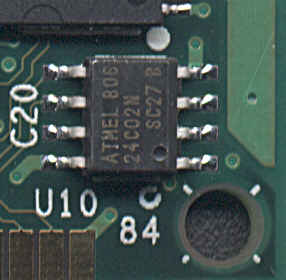
Picture of a 8pin-SPD EEPROMmade by Atmel
Serial Presence Detect (SPD) data is probably the most misunderstood subject in the memory module industry.
Most people only know it as the little Eprom device on the DIMM that often kept the module from working properly in the computer. On the contrary, it is quite the opposite. The SPD data actually provide vital information to the
system Bios to keep the system working in optimal condition with the memory DIMM. This article attempts to guide you through the construction of an SPD table with 揟urbo-Tax?type of multiple choices questions. I hope you抣l find it interesting and useful.
Byte 0
Number of Serial PD Bytes written during module production
This field describes the total number of bytes used by the module manufacturer for the SPD data and any (optional)
specific supplier information. The byte count includes the fields for all required and optional data.
For most manufacturers, they do not insert optional data and the resulting data (in hex) would normally be:
128Byte: 80h 256Byte: FFh
Byte 1
Total number of Bytes in Serial PD device
This field describes the total size of the serial memory used to hold the Serial Presence Detect data,
device used is usually 128 Bytes or 256 Bytes with 256 Bytes as the most common.
256 Byte (24C02)
(34C02) with Software Write Protect function
(34C02B)with Reversible Software Write Protect function :08h
128 Byte (24C01): 07h
Byte 2
Fundamental Memory Type
This refers to the DRAM type. In this case, we are only dealing with DDR2 SDRAM.
DDR2 SDRAM: 08h
Byte 3
Number of Row Addresses on this assembly
This relates to the DRAM size as well as the Refresh scheme of the DRAM.
The best way to discover this is to use the AutoID function of the CST DIMM tester.
You would first run the AutoID on the tester.
You then use the [Edit] [AdrDat] function to display the Row and Column Address counts.
15: 0Fh 14: 0Eh 13: 0Dh 12: 0Ch
Byte 4
Number of Column Addresses on this assembly
This relates to the DRAM size as well as the Refresh scheme of the DRAM.
The best way to discover this is to use the AutoID function of the CST DIMM tester.
You would first run the AutoID on the tester. You then use the [Edit] [AdrDat] function
to display the Row and Column Address counts. 13: 0Dh 12: 0Ch 11: 0Bh 10: 0Ah 09: 09h
Byte 5
Module Attributes - Number of Physical Banks on DIMM, Package and Height
This is a multi-purpose field that involves calculations and bit combination.
A Flash program combine them together and give you an automatic result after
you have selected the different attributes.
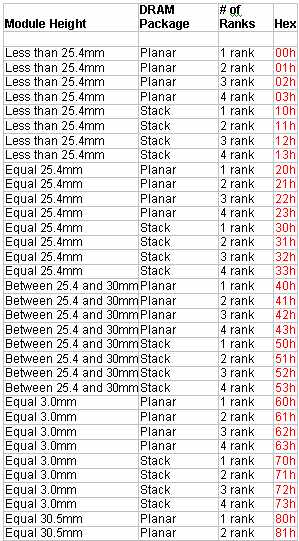
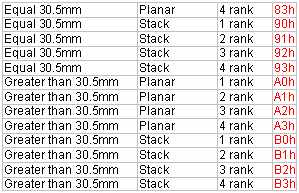
Byte 6
Module Data Width of this assembly
This refers to the number of data bit width on the module. For a standard 8 byte DIMM, 64 bits
would be most common while an 8 byte ECC module would have 72 bits. Some special module might
even have up to 144 bits. In any case, a CST tester Auto ID function would tell you this number
in plain English.
32 bit: 20h 64 bit: 40h 72 bit: 48h 144 bit: 90h
Byte 7
Reserved
Not available: 00h
Byte 8
Voltage Interface Level of this assembly
This refers to the power supply voltage Vdd of the DIMM. Standard DDR2 SDRAM module would be SSTL 1.8V
1.8V DDR2: 05h Recommended Default
Byte 9
SDRAM Device Cycle time
This commonly referred to the clock frequency of the DIMM. Running at its specified CL latency.
5.0 ns (400Mhz): 50h 3.75 ns (533Mhz): 3Dh 3.0 ns (667Mhz): 30h
2.5 ns (800Mhz): 25h
Byte 10
SDRAM Device Access from Clock (tAC)
This byte defines the maximum clock to data out time for the SDRAM module. You can normally
read off the tAC specification on the Timing Parameter table.
+/-0.6 ns: 60h
+/-0.5 ns: 50h
+/-0.45 ns: 45h
+/-0.40 ns: 40h
Byte 11
DIMM Configuration Type
This is to identify the DIMM as ECC, Parity, or Non-parity. Normally non-parity is related to
64 bit module, Parity and ECC are related to 72 bit or higher memory bit width on the module.
NonECC: 00h
ECC: 02h
Address/Command Parity with ECC: 06h
Byte 12
Refresh Rate
This byte describes the module's refresh rate and if it is self-refreshing or non-self refreshing.
Today, most standard modules would be capable of self-refreshing. The refresh time is easily read
from the DRAM manufacturer data sheet. Refresh time can be listed in two different ways.
1. In Refresh Interval Time. For example: 15.6usec. or 7.8usec.
2. In milli-seconds per x Refresh Cycles. For example: 62.4ms in 8K refresh
This can be converted back into refresh interval time with the equation:
Refresh Interval = Total Refresh Period/number of refresh cycles.
15.6 us Self-refresh (4K): 80h 7.8 us Self-refresh (8K): 82h
15.6 us non Self-refresh : 00h 7.8 us non Self-refresh : 02h
Byte 13
Primary SDRAM Width
This refers to the bit width of the primary data SDRAM.
For a standard DIMM module. 4 bits: 04h 8 bits: 08h 16 bits: 10h
Byte 14
Error Checking SDRAM Width
This refers to the bit width of the error checking DRAM. For a standard module,
it is either no ECC bit, or 8 bits on a regular 8 byte module. It can also be 16 bits on
a 144 bit (16 byte) module.
No-ECC: 00h 8bits: 08h 16bits: 10h
Byte 15
Reserved
Not available: 00h
Byte 16
Burst Lengths Supported
This is indicates the burst length supported. In DDR2, standard DRAM are all 4, 8 burst supported.
4, 8 Burst length supported: 0Ch
Byte 17
Number of Banks on SDRAM Device
This is referring to the internal bank on the DRAM chip. All modern DDR2 chips under 1Gbit have
4 internal banks. For chips at 1Gbit or above, they have 8 internal banks.
4 Internal Banks: 04h 8 Internal Banks (for 1Gb or 2Gb chips only): 08h
Byte 18
CAS Latency (CL)
This refers to the all the different Cas Latency supported by your chip. This can vary with the
frequency you operate your DIMM. This number can be read off your DRAM data sheet.
CL=3 and 4 supported: 18h
CL=4 and 5 supported: 30h
CL=5 and 6 supported: 60h
CL=5 supported: 20h
CL=6 supported: 40h
Byte 19
DIMM Mechanical Characteristics
This defines the module thickness where the maximum thickness includes all assembly parts: devices,
heat spreaders, or other mechanical components. This information together with the DIMM type, allows
the system to adjust for thermal operation specifications.

Byte 20
DIMM type information
This byte identifies the DDR2 SDRAM memory module type.
Each module type specified in this Byte 20 defines a unique index for module thickness specified in Byte 19,
which may be used in conjunction with thermal specifications in Bytes 21 and 47-61 to adjust system operation
conditions based on installed modules.
Undefined 00h
Regular Registered DIMM: 01h
Regular Unbuffered DIMM:02h
SO-DIMM: 04h
Micro-DIMM: 08h
Mini-Registered DIMM: 10h
Mini-Unbuffered DIMM: 20h
Byte 21
SDRAM Module Attributes
This byte involves 4 main items. Bit 0-1 signifies the number of registers on the DIMM. Bit 2-3 signifies
the number of PLL抯 on the DIMM. Bit 4 indicates if any on board FET switch is enabled. Bit 6 indicates
if an analysis probe is installed. In most cases, Bit 4 and Bit 6 are not used.
The resulting hex code is calculated as follows:
0 PLL chip and 1 Register chip 00h
0 PLL chip and 2 Register chip 01h
1 PLL chip and 1 Register chip 04h
1 PLL chip and 2 Register chip 05h
2 PLL chip and 1 Register chip 08h
2 PLL chip and 2 Register chip 09h
Byte 22
SDRAM Device Attributes 朑eneral
This byte is a multi-purpose byte. It includes PASR (Partial Array Self Refresh) , 50 ohm ODT enable and
also support of Weak Driver. The resultant hex code is calculated based on the selection you made.
Supports PASR Supports 50 ohm Supports weak driver HEX
No No No 00h
No No Yes 01h
No Yes No 02h
No Yes Yes03h
Yes No No 04h
Yes No Yes 05h
Yes Yes No 06h
Yes Yes Yes 07h
Byte 23
SDRAM Min Clock Cycle at CLX-1
This is referred to the speed (or frequency) the DRAM can run at when the Cas Latency
is reduced by 1 clock. This data can be looked up from the datasheet of the DRAM.
This is usually listed at the first page of the data sheet where it mentioned highest
frequency it can run at a certain Cas latency setting.
De-rated latency
3.0ns (667 Mhz): 30h
3.75 ns (533Mhz) : 3Dh
5.0 ns (400Mhz) 50h
Undefined: 00h
Byte 24
Max Data Access Time(tAC) at CLX-1
This is referred to DQ output access time from CK/CK* at when the Cas Latency is reduced by 1 clock.
This data can be looked up from the datasheet of the DRAM. This is usually listed as tAC on the data
sheet where it mention maximum frequency it can run at a certain CAS latency setting.
+/-0.45ns: 45h +/-0.5 ns: 50h +/-0.6 ns: 60h Undefined: 00h
Byte 25
SDRAM Min Clock Cycle at CLX-2
This is referred to the speed the DRAM can run at when the Cas Latency is forced to reduce by two notches.
This data can be looked up from the datasheet of the DRAM. This is usually listed at the first page of the
data sheet where it mentioned the frequency it can run at a certain Cas latency setting.
3.75 ns (533Mhz): 3Dh 5.0 ns (400Mhz): 50h Undefined: 00h
Byte 26
Max Data Access Time(tAC)CLX-2
This is referred to DQ output access time from CK/CK* at when the Cas Latency is reduced by 2 clock.
This data can be looked up from the datasheet of the DRAM. This is usually listed as tAC on the data
sheet where it mention maximum frequency it can run at a certain CAS latency setting.
+/-0.45ns: 45h +/-0.5 ns: 50h +/-0.6 ns: 60h
Byte 27
Minimum Row Pre-charge Time (tRP)
This is tRP min read off the DRAM data sheet.
15 ns: 3Ch
Byte 28
Minimum Row to Row Access Delay (tRRD)
This is the tRRD min time read off the DRAM data sheet.
(x4,x8) 7.5ns: lEh (x16) 10 ns: 28h
Byte 29
Minimum Ras to Cas Delay (tRCD)
This is the tRCD min time read off the DRAM data sheet
15 ns: 3Ch
Byte 30
Minimum Active to Pre-charge Time (tRAS)
This is the tRAS min time read of the DRAM data sheet.
40 ns: 28h (For DDR2 533/400Mhz)
39 ns 27h (For DDR2 667 Mhz)
Byte 31
Module Bank Density
This refers to the Mega-Byte in each physical bank (per rank) on the DIMM.
For example: if a 256MB module has two physical banks, then each physical bank
should have 128MB.
128MB: 20h 256MB: 40h 512MB: 80h
1G: 01h 2G: 02h 4G: 04h
Byte 32
Address and Command Input Setup Time Before Clock (tIS)
This refers to the time of the address and command lines have to occur before the
next clock edge. It is labeled as tIS min in the case of DDR2.
DDR2 (tIS) 0.2ns: 20h 0.25 ns: 25h 0.30 ns: 30h 0.35 ns: 35h
Byte 33
Address and Command Input Hold Time After Clock (tIH)
This refers to the period of time the address and command lines have to hold after
the last clock edge has appeared. It is labeled as tIH min in the case of DDR2.
0.275 ns: 27h 0.325ns: 32h 0.375 ns: 37h 0.475 ns: 47h
Byte 34
SDRAM Device Data/Data Mask Input setup Time Before Data Strobe (tDS)
This refers to the time of the Data and Data Mask lines have to occur before the
next clock edge. It is labeled as tDS min in the case of DDR2.
DDR2(tDS) 0.05ns: 05h 0.10 ns: 10h 0.15 ns: 15h
Byte 35
Address and Command Input Hold Time After Clock (tDH)
This refers to the period of time the Data and Data Mask lines have to hold after
the last clock edge has appeared. It is labeled as tDH min in the case of DDR2.
DDR2(tDH)0.175ns: 17h 0.225 ns: 22h 0.275 ns: 27h
Byte 36
Write recovery time (tWR)
This byte describes the write recovery time(tWR)min
15.0 ns: 3Ch
Byte 37
Internal write to read command delay (tWTR)
This byte describes the internal write to read command delay (tWTR)min
7.5 ns: 1Eh 10.0 ns: 28h
Byte 38
Internal read to pre-charge command delay (tRTP)
This byte describes internal read to precharge command delay
(tRTP) 7.5 ns: 1Eh
Byte 39
Memory Analysis Probe Characteristics
This byte describes various functional and parametric characteristics of the memory
analysis probe connected to this DIMM slot. These characteristics may be consulted
by the BIOS to determine proper bus drive strength to account for additional bus
loading of the probe. It also describes functional characteristics of the probe that
may be used to configure the memory controller to drive proper diagnostic signals to
the probe, such as via the TEST,NC pin
Not available: 00h Default value if probe is not described
Byte 40
Extension of Byte 41 tRC and Byte 42 tRFC
This byte serves as an extension when Byte 41 or Byte 42 has run out of space to
accommodate the bigger value
When tRFC (byte 42) is 127.5ns, byte 40 is: 06h
When tRFC (byte 42) is 327.5ns, byte 40 is: 07h
When tRC (byte 41) is 63.75ns, byte 40 is: 50h
When tRC (byte 41) is 65ns, byte 40 is: 00h
Byte 41
Minimum Active to Active Auto Refresh Time (tRCmin)
53ns: 35h 54ns: 36h 55 ns: 37h 60 ns: 3Ch
63.75ns: 8Eh 65ns: 41h
Byte 42
Minimum Auto Refresh to Active Auto Refresh Time (tRFC)
This byte identifies the minimum Auto-Refresh to Active/Auto-Refresh Command Period (tRFC).
(256Mb)75 ns: 4Bh (512Mb)105 ns: 69h
(1Gb) 127.5ns: 7Fh (2Gb) 195ns: C3h
(4Gb) 327.5ns: 47h
Byte 43
Maximum Device Cycle time (tCKmax)
8 ns: 80h
Byte 44
Maximum Skew Between DQS and DQ (tDQSQ)
Maximum DQS tolerance.
0.24 ns: 18h 0.30 ns: 1Eh 0.35 ns: 23h
Byte 45
Maximum Read DataHold Skew Factor (tQHS)
Maximum DOS and DO window tolerance.
0.34 ns: 22h 0.40 ns: 28h 0.45 ns: 2Dh
Byte 46
PLL Relock Time
This refers to the lock time on the PLL IC used in the registered module.
You can read this off the PLL device datasheet.
Undefined: 00h 8us: 08h 10us: 0Ah
12us: 0Ch 15 us: 0Fh
Byte 47 to Byte 61
These bytes describe the thermal characteristic of the memory chips and the logic
chips used on the module. These are complex thermal data used in calculating the
thermal throttling of the microprocessor speed under overstress conditions. In most systems,
these data are ignored (or not available).
Byte 47
Tcasemax
Bits 7:4: Tcasemax Delta, the baseline maximum case temperature is 85 OC. Bits 3:0: DT4R4W Delta.
Not available: 00h
Byte 48
Psi T-A DRAM
Thermal resistance of DRAM device package from top (case) to ambient (Psi T-A DRAM)
Not available: 00h
Byte 49
DTO/Tcase Mode Bits
Bits 7:2:Case temperature rises from ambient due to IDDO/activate-pre- charge operation minus 2.8 OC
offset temperature. Bit 1: Double Refresh mode bit. BitO High Temperature self-refresh rate support
indication
Not available: 00h
Byte 50
DT2N/DT2Q
Case temperature rises from ambient due to IDD2N/precharge standby operation for UDIMM and due to
IDD20/precharge quiet standby operation for RDIMM.
Not available: 00h
Byte 51
DT2P
Case temperature rises from ambient due to IDD2N/precharge standby operation for UDIMM and due to
IDD20/precharge quiet standby operation for RDIMM.
Not available: 00h
Byte 52
DT3N
Case temperature rises from ambient due to IDD2P/precharge power-down operation
Not available: 00h
Byte 53
DT3Pfas
Case temperature rises from ambient due to IDD3P Fast PDN Exit/active power-down with Fast PDN
Exit operation
Not available: 00h
Byte 54
DT3Pslow
Case temperature rises from ambient due to IDD3P Slow PDN Exit/active power-down with Slow PDN
Exit operation
Not available: 00h
Byte 55
DT4R/Mode Bit
Bits 7:1: Case temperature rises from ambient due to IDD4R/page open burst read operation.
Bit 0: Mode bit to specify if DT4W is greater or less than DT4R
Not available: 00h
Byte 56
DT56
Bits 7:1: Case temperature rises from ambient due to IDD4R/page open burst read operation.
Bit 0: Mode bit to specify if DT4W is greater or less than DT4R
Not available: 00h
Byte 57
DT7
Case temperature rise from ambient due to IDD7/bank interleave read mode operation
Not available: 00h
Byte 58
Psi T-A PLL
Thermal resistance of PLL device package from top (case) to ambient (Psi T-A PLL)
Not available: 00h
Byte 59
Psi T-A Register
Thermal resistance of register device package from top (case) to ambient (Psi T-A Register)
Mot available: 00h
Byte 60
DT PLL Active
Case temperature rises from ambient due to PLLin active mode atVCC = 1.9 V the PLL loading is the DIMM loading
Not available: 00h
Byte 61
DT Register Active/Mode Bit
Bits 7:1: Case temperature rises from ambient due to register in active mode at VCC = 1.9 V,
the register loading is the RDIMM loading. Bit 0: mode bit to specify register data output toggle rate 50% or 100%
Not available: 00h
Byte 62
SPD Data Revision Code
Revision 1.0: 10h Revision 1.1: 11 h Revision 1.2: 12h
Byte 63
Checksum for Byte 0 to 62
Checksum is calculated and placed into this byte. All CST testers have automatic checksum calculation for this byte.
All you have to do is to fill in and audit byte 0-62, the tester will automatically fill in byte 63 for you
through the auto-checksum calculation.
Byte 64-71
Manufacturer抯 JEDEC ID Code
This is a code obtained through manufacturer抯 registration with JEDEC ( the standard setting committee).
A small fee is charged by JEDEC to support and maintain this record. Please contact JEDEC office.
Byte 64 is the most significant byte. If the ID is not larger then one byte (in hex), byte 65-71 should be
filled with 00h.
Byte 72
Module manufacturing Location
Optional manufacturer assigned code.
Byte 73-90
Module Part Number
Optional manufacturer assigned part number.
The manufacturer抯 part number is written in ASCII format within these bytes. Byte 73 is the most
significant digit in ASCII while byte 90 is the least significant digit in ASCII. Unused digits are
coded as ASCII blanks (20h).
Byte 91-92
Module Revision Code
Optional manufacturer assigned code.
Byte 93-94
Module Manufacturing Date
Byte 93 is the year: 2005 69h 2006 6Ah 2007 6Bh
Byte 94 is the week of the year: wk1-wk15 01h ?0Fh
wk16-wk31 10h ?1Fh
wk32-wk47 20h ?2Fh
wk48-wk52 30h ?34h
Byte 95-98
Module Serial Number
Optional manufacturer assigned number.
On the serial number setting, JEDEC has no specification on the data format nor dictates
the location of Most Significant Bit. Therefore, it抯 up to individual manufacturer to
assign his numbering system. All CST testers and EZ-SPD programmers have the option for
user to select either byte 95 or byte 98 as the MSB (most significant bit). The testers
assume the use of ASCII format; which is the most commonly used. The CST testers also have
the function to automatically increment the serial number on each module tested.
Byte 99-127
Manufacturer抯 Specific Data
Optional manufacturer assigned data.
Byte 128-255
Open for Customer Use
Optional for any information codes.
Final Note:
Everything in the above article and more are now implemented into the CST EZ-SPD DDR2
Programmer software. The new features are:
1. Pop up window of explanation on each Byte.
2. Clickable selection right from the illustration window.
3. Auto checksum on byte 62.
4. Text input on "manufacturer code" and "serial number". User define MSB/LSB format.
5. Auto JEDEC week and year coding from PC clock.
6. Software write protect function.
.....just to name a few.
For further information, please view : www.simmtester.com
DDR2 SPD tablereference from Micron Technology
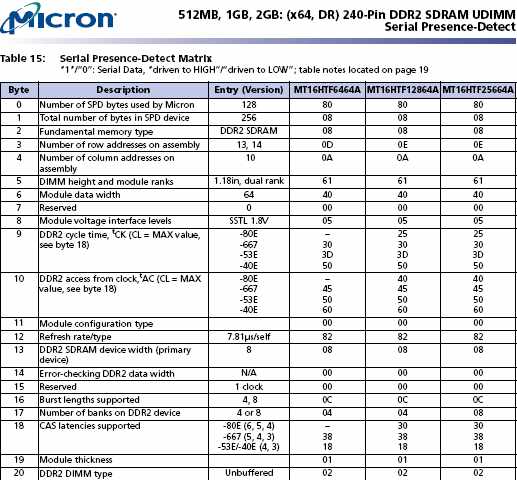
Byte 21- 27

Byte 28 -40
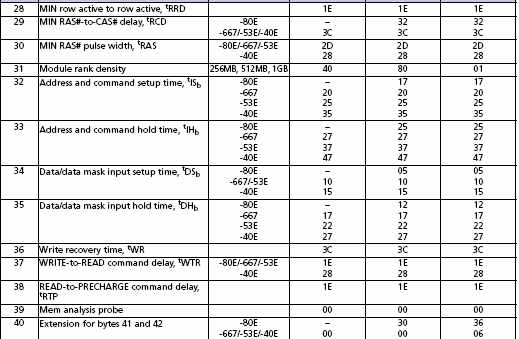
Byte 41 - 63
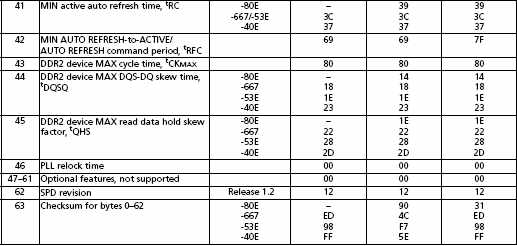
Byte 64- 127

|

















相关推荐
文件中提到在Menlow平台上遇到的DDR2内存兼容性bug问题,这可能是因为DIMM SPD中的某些参数未能与主板或处理器兼容。通过研究DIMM SPD数据和Award内存初始化部分,可以发现并修复内存兼容性问题。 DIMM SPD数据还...
SPD是嵌入在DDR2内存模块上的小芯片,存储了关于内存的重要信息,包括制造商信息、内存容量、速度、CAS延迟、电压规格等。这些信息对于系统BIOS识别和正确配置内存至关重要。当计算机启动时,BIOS会读取SPD信息来...
### DDR2 SDRAM SPD技术规范解析 #### 一、引言 JEDEC官方发布的DDR2 SDRAM SPD(Serial Presence Detect)标准技术规范是定义DDR2内存模块关键参数的重要文档。这份文档提供了关于DDR2 SDRAM模块的详细信息,包括...
金士顿2g 双面16粒DDR2 800 SPD
金士顿DDR2 2G 800内存条SPD信息
### DDR2 SPD Revision 1.1 标准详解 #### 一、标准概述 DDR2 SPD Revision 1.1 标准是由 JEDEC (Joint Electron Device Engineering Council)半导体协会制定的一项重要规范。此标准旨在定义 DDR2 SDRAM 模块序列...
金士顿DDR2 2G 800内存条SPD信息
### DDR2 SPD 内存规范概述 DDR2内存技术作为DDR SDRAM的一种演进版本,在存储性能、功耗控制及稳定性方面均有显著提升。本文旨在详细介绍DDR2 SPD(Serial Presence Detect)规范,以便更好地理解DDR2内存的工作...
### DDR2 SPD 规格说明 #### 一、引言 DDR2 SPD(Serial Presence Detect)规格说明书旨在为DDR2版本的同步动态随机存取内存(SDRAM)模块提供序列存在检测规范。这些规范在SPD标准文档中的“特定特性”部分有所...
标题中的"JEDEC SPD4.1.2.10:2007 DDR2 SPD Document Release 1.3(R17)"指的是JEDEC发布的关于DDR2 SPD的特定版本文档,具体为2007年的第四部分第1.2.10节,版本号1.3,修订版R17。这个文档详细阐述了DDR2内存模块...
DDR2 内存条的 SPD(Serial Presence Detect)信息是存储在内存模块上的微型 EEPROM(电可擦除可编程只读存储器)芯片中的一组数据,它包含了内存条的制造商、型号、速度、时序等关键信息。这些信息被主板用来正确...
"SPD"代表Serial Presence Detect,是内存在其DIMM模块上的一个小型EEPROM芯片。它存储了关于内存条的关键信息,如制造商、容量、速度、时序等。这些信息对系统BIOS至关重要,因为它用来自动配置内存设置,确保内存...
本压缩包集合了多种类型的SPD文件,涵盖了从早期的SDR(Single Data Rate)内存到后来的DDR(Double Data Rate)系列,包括DDR2和DDR3内存。 1. SDR内存:SDR内存是早期的PC内存标准,其数据传输速率仅为单倍时钟...
这个EEPROM芯片通常位于DIMM(双列直插式内存模块)的边缘,便于系统读取。 SPD数据包含了内存条的多种关键参数,这对于系统识别和正确配置内存至关重要。这些信息包括但不限于: 1. **内存芯片及模组厂商**:表明...
组件详情部分列出了构成EP2-2100 DDR2 SDRAM SO-DIMM的所有元件,包括DDR2 SDRAM芯片、SPD(串行存在检测)芯片、电阻、电容等。这些信息对于理解模块的整体设计和性能至关重要。 ### Unbuffered 32b SO-DIMM详情与...
DDR3 规格的 Serial Presence Detect (SPD) 表是存储在 DIMM 的 EEPROM 中的,它提供了关于内存模块的重要信息,例如内存大小、时钟频率、电压等。 在 DDR3 SPD 表中, Byte 0 是最重要的,它描述了内存模块的总...
512M DDR2 533 金士顿内存 SPD
原装dell 海力士ddr2 800 1g和2g spd+ spdtool原装dell 海力士ddr2 800 1g和2g spd+ spdtool原装dell 海力士ddr2 800 1g和2g spd+ spdtool
"SPD (Serial Presence Detect)" 是一种在内存模块(如DDR3、DDR2)中用于存储关键信息的技术。这项技术由JEDEC固态技术协会制定,目的是为了简化系统的配置过程,使得计算机能够自动识别和配置内存条的参数,如速度...